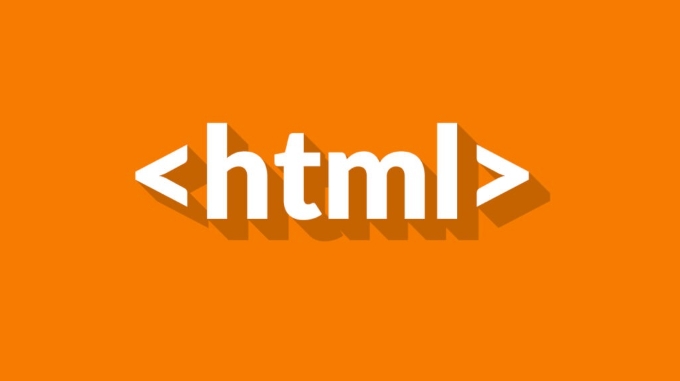To create a range slider, use the HTML <input type="range"> tag. 1. Set the min and max attributes to define the numerical range; 2. Use value to specify the initial value; 3. Use step to control the step to limit the optional numerical interval; 4. Add tick marks in conjunction with <datalist> to improve visual interaction; 5. Use JavaScript to obtain and respond to changes in slider values, and often use input or change events to listen to user operations; 6. Pay attention to practical application issues such as mobile compatibility, barrier-free support and custom styles.

To create a range slider in HTML, you only need to use the <input> tag to match type="range" . Its function is to allow users to select a value within a set range, which is often used in scenarios such as volume control and scoring systems.

Basic structure
Creating a most basic range slider is very simple, you only need to write a line of HTML:

<input type="range">
This displays a slider with a default minimum value of 0 and a maximum value of 100. You can adjust the range by setting min and max properties, such as:
<input type="range" min="10" max="200">
You can also add value attribute to set the initial value, for example:

<input type="range" min="0" max="100" value="50">
This will allow the slider to stop in the middle position at the beginning.
Add step size and scale
If you want the user to only select values ??for a specific interval, such as increasing by 5 per slide instead of continuous changes, you can use step attribute:
<input type="range" min="0" max="100" step="5">
In this way, users can only select values ??such as 0, 5, 10...100.
However, it should be noted step is optional, and if not set, the default is 1. If you set too large a step, it may make the user experience worse, especially in scenarios where fine adjustments are required.
In addition, HTML itself does not support the addition of tick marks or tags directly, but the effect with marking points can be achieved by combining <datalist> :
<input type="range" list="tickmarks" min="0" max="100" step="10"> <datalist id="tickmarks"> <option value="0"></option> <option value="20"></option> <option value="40"></option> <option value="60"></option> <option value="80"></option> <option value="100"></option> </datalist>
In this way, the browser will display some visual tick points to enhance the interactive experience.
Get and use the value of the slider
It is not enough to have a slider alone, we usually need to get the value selected by the user. This can be implemented through JavaScript.
Add an id to the slider and listen for input or change events:
<input type="range" id="slider" min="0" max="100" value="50">
<p>Current value: <span id="output">50</span></p>
<script>
const slider = document.getElementById('slider');
const output = document.getElementById('output');
slider.addEventListener('input', function() {
output.textContent = slider.value;
});
</script>- Use
inputevent to update the value in real time during the slide; - If you only care about the end result, you can use the
changeevent, which will be triggered only after the user releases the mouse.
You can also pass the value to other functions for processing, such as adjusting the volume, changing the color depth, etc.
Some common things to note
- Mobile compatibility : Modern browsers basically support range type, but on iOS, the style is much limited and the appearance cannot be fully customized.
- Accessibility support : Remember to add
aria-labelorlabel forto facilitate screen readers' recognition. - Style customization : Although native controls are ugly, the appearance can be modified through CSS, especially the track and slider parts. Just pay attention to browser compatibility, especially the style writing of the WebKit kernel.
Basically that's it. Although the functions are simple, it can improve a lot of interactive experience if used properly.
The above is the detailed content of How to create a range slider in HTML?. For more information, please follow other related articles on the PHP Chinese website!

Hot AI Tools

Undress AI Tool
Undress images for free

Undresser.AI Undress
AI-powered app for creating realistic nude photos

AI Clothes Remover
Online AI tool for removing clothes from photos.

Clothoff.io
AI clothes remover

Video Face Swap
Swap faces in any video effortlessly with our completely free AI face swap tool!

Hot Article

Hot Tools

Notepad++7.3.1
Easy-to-use and free code editor

SublimeText3 Chinese version
Chinese version, very easy to use

Zend Studio 13.0.1
Powerful PHP integrated development environment

Dreamweaver CS6
Visual web development tools

SublimeText3 Mac version
God-level code editing software (SublimeText3)

Hot Topics
 Explain the purpose of the role attribute in ARIA.
Jun 14, 2025 am 12:35 AM
Explain the purpose of the role attribute in ARIA.
Jun 14, 2025 am 12:35 AM
ARIA's role attribute is used to define the role of web elements and improve accessibility. 1. Role attribute helps assistive technology to understand the functions of elements, such as buttons, navigation, etc. 2. Use role attributes to assign specific roles to non-semantic HTML elements. 3. The role attribute should be consistent with the element behavior and be verified by the accessibility tool test.
 HTML and Design: Creating the Visual Layout of Websites
Jun 14, 2025 am 12:39 AM
HTML and Design: Creating the Visual Layout of Websites
Jun 14, 2025 am 12:39 AM
How to create a website layout? 1. Use HTML tags to define the content structure, such as, ,. 2. Control styles and positions through CSS, using box model, float or Flexbox layout. 3. Optimize performance, reduce HTTP requests, use cache and optimize images, and ensure responsive design.
 How can you ensure your HTML code is readable and maintainable?
Jun 10, 2025 am 12:06 AM
How can you ensure your HTML code is readable and maintainable?
Jun 10, 2025 am 12:06 AM
Improve the readability and maintainability of HTML code can be achieved through the following steps: 1. Use semantic tags, such as, etc. to make the code structure clear and improve SEO effect; 2. Keep the code formatted and use consistent indentation and spaces; 3. Add appropriate comments to explain the code intention; 4. Avoid excessive nesting and simplify the structure; 5. Use external style sheets and scripts to keep the HTML concise.
 How do I stay up-to-date with the latest HTML standards and best practices?
Jun 20, 2025 am 08:33 AM
How do I stay up-to-date with the latest HTML standards and best practices?
Jun 20, 2025 am 08:33 AM
The key to keep up with HTML standards and best practices is to do it intentionally rather than follow it blindly. First, follow the summary or update logs of official sources such as WHATWG and W3C, understand new tags (such as) and attributes, and use them as references to solve difficult problems; second, subscribe to trusted web development newsletters and blogs, spend 10-15 minutes a week to browse updates, focus on actual use cases rather than just collecting articles; second, use developer tools and linters such as HTMLHint to optimize the code structure through instant feedback; finally, interact with the developer community, share experiences and learn other people's practical skills, so as to continuously improve HTML skills.
 How do I use the element to represent the main content of a document?
Jun 19, 2025 pm 11:09 PM
How do I use the element to represent the main content of a document?
Jun 19, 2025 pm 11:09 PM
The reason for using tags is to improve the semantic structure and accessibility of web pages, make it easier for screen readers and search engines to understand page content, and allow users to quickly jump to core content. Here are the key points: 1. Each page should contain only one element; 2. It should not include content that is repeated across pages (such as sidebars or footers); 3. It can be used in conjunction with ARIA properties to enhance accessibility. Usually located after and before, it is used to wrap unique page content, such as articles, forms or product details, and should be avoided in, or in; to improve accessibility, aria-labeledby or aria-label can be used to clearly identify parts.
 How do I create a basic HTML document?
Jun 19, 2025 pm 11:01 PM
How do I create a basic HTML document?
Jun 19, 2025 pm 11:01 PM
To create a basic HTML document, you first need to understand its basic structure and write code in a standard format. 1. Use the declaration document type at the beginning; 2. Use the tag to wrap the entire content; 3. Include and two main parts in it, which are used to store metadata such as titles, style sheet links, etc., and include user-visible content such as titles, paragraphs, pictures and links; 4. Save the file in .html format and open the viewing effect in the browser; 5. Then you can gradually add more elements to enrich the page content. Follow these steps to quickly build a basic web page.
 How do I create checkboxes in HTML using the element?
Jun 19, 2025 pm 11:41 PM
How do I create checkboxes in HTML using the element?
Jun 19, 2025 pm 11:41 PM
To create an HTML checkbox, use the type attribute to set the element of the checkbox. 1. The basic structure includes id, name and label tags to ensure that clicking text can switch options; 2. Multiple related check boxes should use the same name but different values, and wrap them with fieldset to improve accessibility; 3. Hide native controls when customizing styles and use CSS to design alternative elements while maintaining the complete functions; 4. Ensure availability, pair labels, support keyboard navigation, and avoid relying on only visual prompts. The above steps can help developers correctly implement checkbox components that have both functional and aesthetics.
 What is an HTML tag?
Jun 13, 2025 am 12:36 AM
What is an HTML tag?
Jun 13, 2025 am 12:36 AM
HTMLtagsareessentialforstructuringwebpages.Theydefinecontentandlayoutusinganglebrackets,ofteninpairslikeand,withsomebeingself-closinglike.HTMLtagsarecrucialforcreatingstructured,accessible,andSEO-friendlywebpages.






